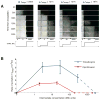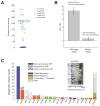Spatiotemporal microbial evolution on antibiotic landscapes
- PMID: 27609891
- PMCID: PMC5534434
- DOI: 10.1126/science.aag0822
Spatiotemporal microbial evolution on antibiotic landscapes
Abstract
A key aspect of bacterial survival is the ability to evolve while migrating across spatially varying environmental challenges. Laboratory experiments, however, often study evolution in well-mixed systems. Here, we introduce an experimental device, the microbial evolution and growth arena (MEGA)-plate, in which bacteria spread and evolved on a large antibiotic landscape (120 × 60 centimeters) that allowed visual observation of mutation and selection in a migrating bacterial front. While resistance increased consistently, multiple coexisting lineages diversified both phenotypically and genotypically. Analyzing mutants at and behind the propagating front, we found that evolution is not always led by the most resistant mutants; highly resistant mutants may be trapped behind more sensitive lineages. The MEGA-plate provides a versatile platform for studying microbial adaption and directly visualizing evolutionary dynamics.
Copyright © 2016, American Association for the Advancement of Science.
Figures




Comment in
-
Visualizing evolution as it happens.Science. 2016 Sep 9;353(6304):1096-7. doi: 10.1126/science.aah5641. Science. 2016. PMID: 27609874 No abstract available.
References
-
- Weinreich DM, Delaney NF, DePristo MA, Hartl DL. Darwinian Evolution Can Follow Only Very Few Mutational Paths to Fitter Proteins. Science. 2006;312:111–114. - PubMed
-
- Lane PG, Hutter A, Oliver SG, Butler PR. Selection of Microbial Mutants Tolerant To Extreme Environmental Stress Using Continuous Culture-Control Design. Biotechnol Prog. 1999;15:1115–1124. - PubMed
-
- Imamovic L, Sommer MOA. Use of collateral sensitivity networks to design drug cycling protocols that avoid resistance development. Sci Transl Med. 2013;5:204ra132. - PubMed
Publication types
MeSH terms
Substances
Grants and funding
LinkOut - more resources
Full Text Sources
Other Literature Sources
Medical

